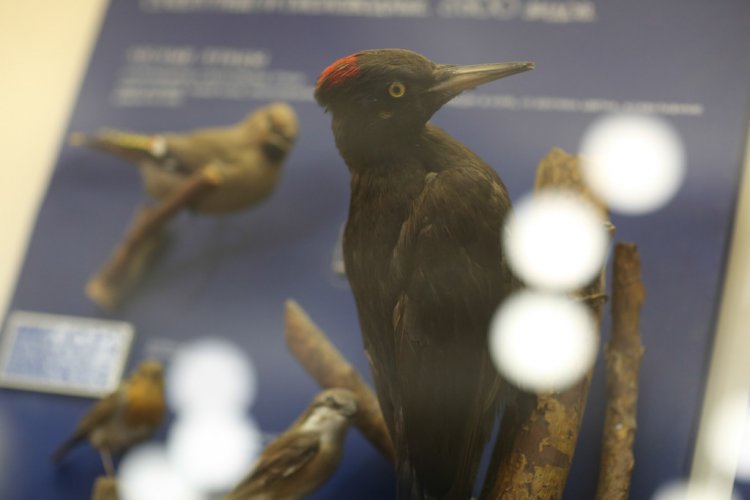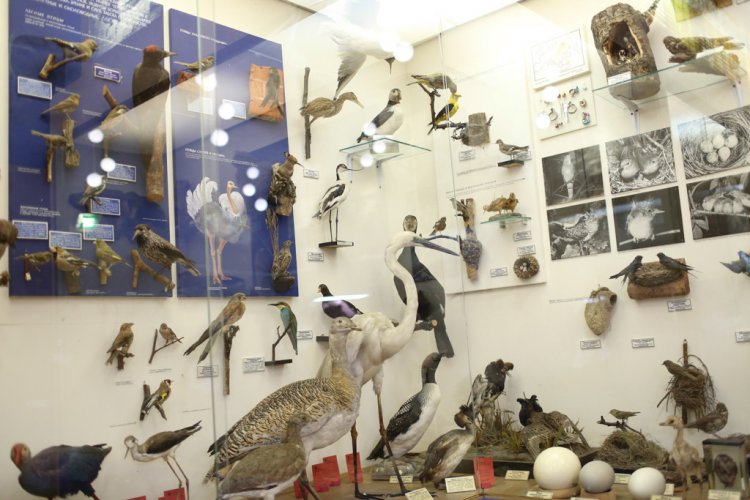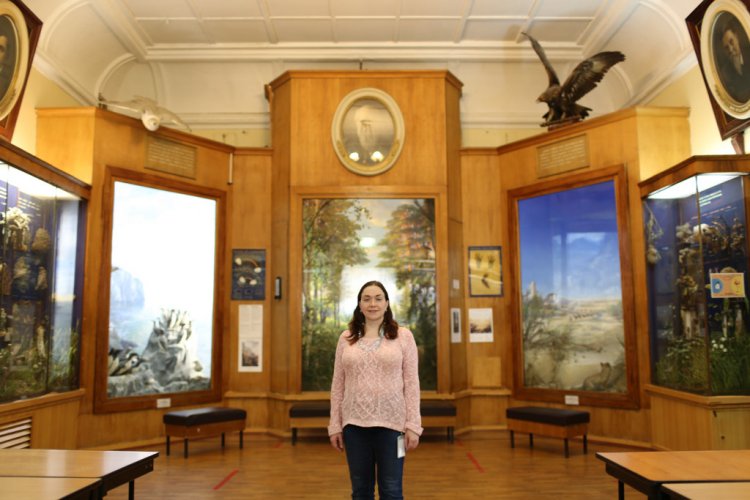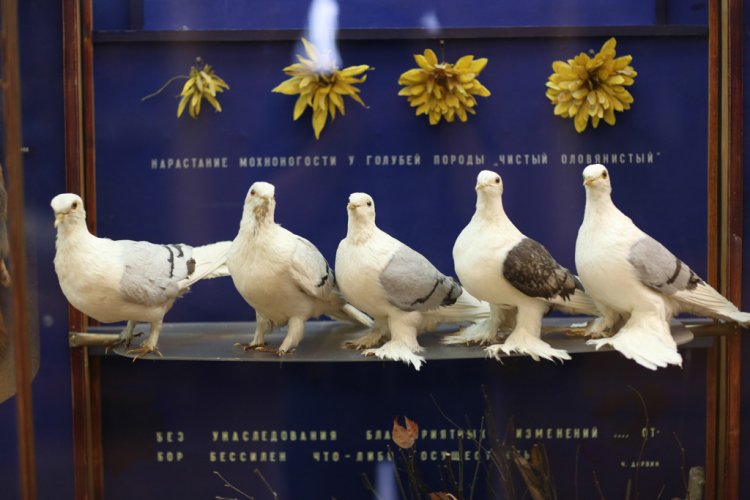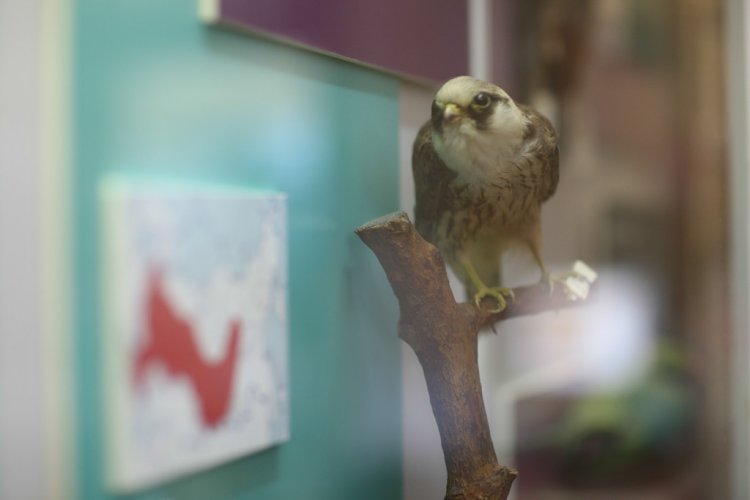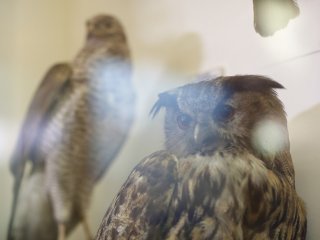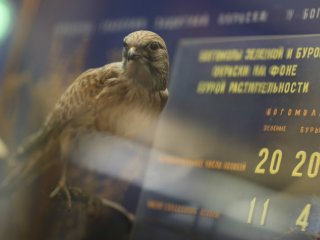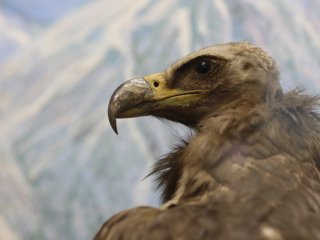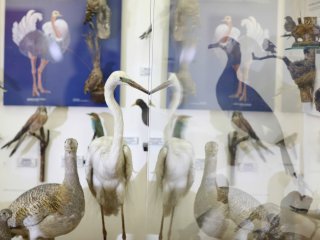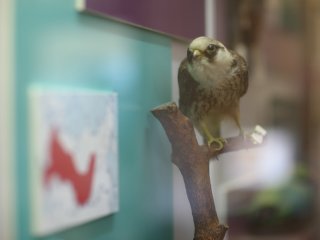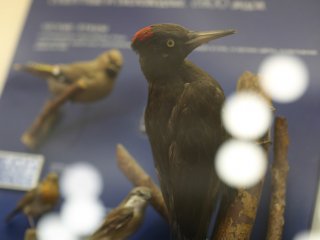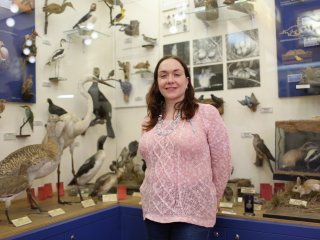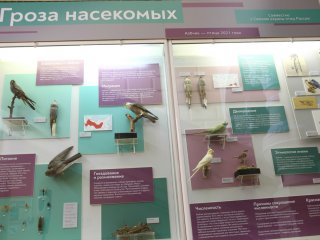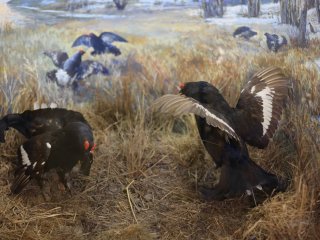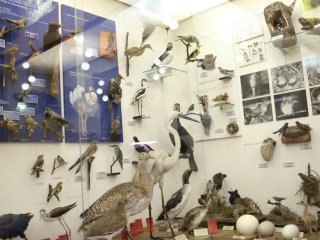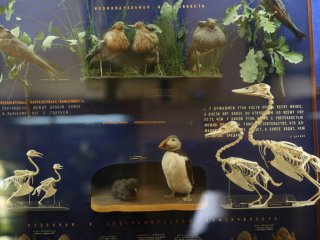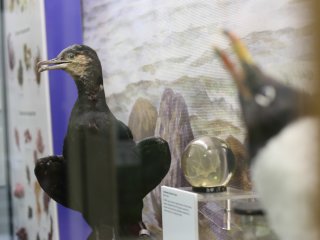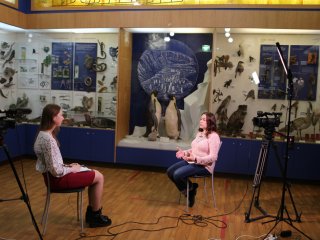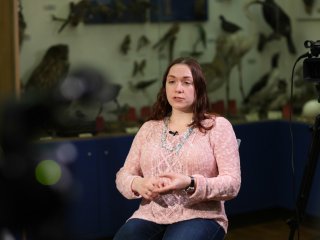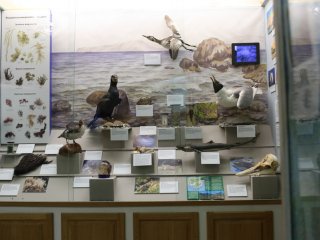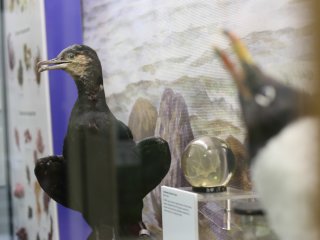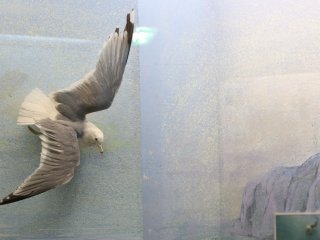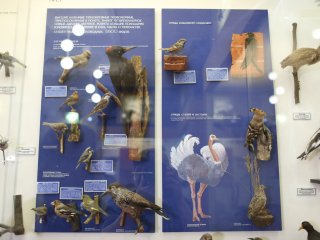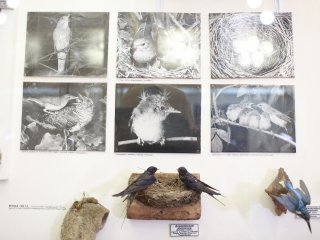Olga Alexandrovna Kalashnikova.
Photo: Andrey Luft / Scientific Russia
Why do birds sing in spring? What makes them fly away from warmer areas? Which of birds can be compared to crows in mental abilities? Olga Kalashnikova, ornithologist, senior research fellow of the ecology and physiology department at the Timiryazev State Biological Museum, provided the answers to these questions.
– Olga Alexandrovna, please tell me about the research you carry out.
– As for my research profile, I study birds of prey, namely we deal with monitoring, perennial changes in nesting and population of birds of prey. The species I study include common buzzard, black kite and small falcons like kestrel or harrier. This sort of birds. There are rare birds like snake eagle among them.
– How is research carried out in a museum? It is not common practice for museums, is it?
– Actually, all specialists working at museums are research fellows. They have different specialization profiles: some of them deal with mouse-like animals; others study rodents, while my area of research as ornithologist is about birds. It is very important for us, as we work at a science museum. We should highlight not only the things that textbooks contain, but the results of some new research in the field of global science. Some studies serve as the basis for excursions, interactive sessions and lectures.
– You study the perennial dynamics and density of diurnal birds of prey. How is the density changing? Does the population of birds rise or drop, and at the expense of what?
Black woodpecker. The bird lives in the forests of Eurasia and feeds on wood insects including ants.
Photo: Andrey Luft / Scientific Russia
– As for Lipetsk region [Olga Kalashnikova carries out her research in this area], the common trend is unfortunately drop in density. The reason behind it lies in aggressive impact on farming lands. I mean, first, the reduction of free lands – meadows – as the people tend to use increasingly more territories as farming lands: they delve and sow. Second, it is the use of various chemical agents, insecticides first of all. The initial task is clear – it is the protection of crops as much as possible. However, such activities lead to a problem – one can find neither insects nor insectivorous birds and mouse-like rodents on these fields, and it becomes a real tragedy for diurnal birds of prey: they have nothing to eat due to the absence of mice. Naturally, they start moving to the areas with no farming lands that people are cultivating. It is a serious problem indeed.
On the other hand, the population of such a falcon as common kestrel was rising rapidly and has recently stabilized. The fact is that in our region the kestrel lives only in the nests of ravens built exclusively on the power line poles. Why it is so? We think that the reason behind it lies in the devastating activities of martens. Being a predator, the marten climbs trees easily and destroys nests eating eggs and chicks. As for power line poles, the marten meets with difficulties as it is not easy to climb a concrete pole. It appears that the kestrel has found such a wonderful way out. However, instead of building its own nest, the kestrel settles in the nest of ravens – crow or rook for instance – and brings out nestlings there. It might probably reach some peak or threshold. Coming back to the topic of agriculture, if there are no insects, the bird has nothing to eat, as kestrel mostly feeds on big insects and small mouse-like rodents. Naturally, it makes a very strong impact on its population. There is the second extremity – the people forget about their farming lands. Subsequently overgrowth of fields takes place, and it becomes difficult for a bird of prey to catch a mouse, even if it sees the rodent. So, it is a story about moderate human agricultural activity. As one of my colleagues says, “Nonetheless, the birds of prey are geared towards the peasant.” She means that the peasants deal with agriculture, i.e. delve and sow, on the one hand, yet their activities are moderate, not aggressive, on the other hand.
However, fairness requires me to say that this trend is typical of not only Russia, but Europe as well. The aggressive use of chemical agents leads to adverse effect not only in Central Russia, but Germany and the Netherlands as well. Europe also suffers from its own problems related to birds of prey, insects and bees. It is a common trend.
Class Aves at the Timiryazev State Biological Museum
Photo: Andrey Luft / Scientific Russia
– To what extent is it common for the birds to occupy the nests of other species?
– Such things happen. For instance, long-eared owl does not build nests as a rule, but occupies the ones of other birds. It may be the nest of a bird of prey or the one of crow. Such birds as falcon, red-footed falcon, kestrel and hobby do not build their own nests either. They occupy the nests of other birds, mostly ravens. It is a sort of historical artful design – raves chase hawks and kestrels, on the one hand, and constitute a very important condition for the very existence of these birds of prey, on the other hand. If we want to have large population of hobbies and kestrels, we should not destroy the ravens’ nests, as they constitute an important condition for nesting of these birds of prey.
There is one more nuance. Birds of prey may swap nests. This year, we see how a common buzzard builds its own nest, and a year later we find a black hawk instead of buzzard in this nest. It is also typical for birds of prey. They have a nesting area, some territory which they protect, yet there may be several nests on this territory that they change depending upon the season. However, they may also settle in one and same nest for several years in a row – 5-7 years or even more. Most often, the change of nests is caused by sanitary and hygienic reasons. It appears that birds’ parasites gather in the nest for a season, and the bird has to move to another nest where there are fewer parasites to get rid of them.
– Raven is famous for its intellect. Are there any other birds which can be compared with ravens in mental abilities?
– I would say that the crow, not raven is meant. It is the crow that is a real feathered primate. The crow is an extremely highly intelligent bird. I would even say that it outstrips raven in intellectual abilities. There is a certain myth that the raven a) lives very long, for centuries (which is not true); and b) that it is the wisest of all birds. The latter laurels ought to be handed over to the crow.
At the respective department of the Moscow State University, they carry out serious research devoted to intellectual development of corvid birds. The studies are conducted under the guidance of Zoya Zorina. A whole laboratory is involved in this project. Other groups of feathered intellectuals include Strigiformers (owls) and Psittaciformes (parrots). I mean big parrots like African gray parrot and cockatoo.
– Once, I have witnessed the situation of several crows as if joking at a cat. What do they do it for?
– I cannot answer this question. By the way, I do not rule out that these birds have not only a sense of humor, but some malicious intentions as well. I mean that they may translate their emotions or rueful feelings in such a way. It is really so. They use to joke at not only cats, but dogs, foxes and other birds… Yes, there are such examples. It must show that they can really boast of high level of intellect being capable of doing such things. I do not even mention about their aggressive behavior during the nesting period. Indeed, due to this kind of behavior, the idea to come up to the nest and take a fledgling crow in hand will hardly cross anybody’s mind. The majority of people know that its parent is sitting somewhere nearby, and those who dare may take a knock on the head, as the crow would not hesitate to put its beak into action. It is a real problem for the visitors of parks. They think that they find poor and pitiable nestlings which they consider abandoned and take them home, to the nearest Zoo or some zoological clinic trying to save them. Such attempts end in a tragedy as a rule. I would like to warn everybody against touching the hatchlings or fledglings, as their parents are definitely somewhere nearby. It is not at all easy to raise a nestling. Besides, what should you do it for? You are not their parents. Anyway, the idea of taking a child who stands near a store waiting for his mother to finish shopping does not come into your mind, does it?
Olga Kalashnikova in one of historical halls of the Timiryazev State Museum
Photo: Andrey Luft / Scientific Russia
– Now we have spring, the time of birds singing… Why do birds sing? Do all of them have such a habit? How long will they do it? Do they sing in winter as well?
– Surprising it may seem, but birds sing in the winter too, yet not all of them do it. On may hear some bird quavering out on a sunny and relatively warm winter day. As a rule, it is a great titmouse singing. Male species start singing as early as in January. Owls start singing also in winter, in February to be exact. It is the period when long-eared owl and small owl are getting ready for the mating season.
In the vast majority of cases, those which sing are male birds. Such a male bird has several reasons for it. First, it tries to attract female specie, “I am such a beautiful and wonderful birds, so, please, fly to me.” The second reason behind it lies in the fact that the bird has found potential territory for nesting. Thus, by way of singing, it wants to give other birds to note that the territory is occupied, and they should stay away from it. Sometimes, it happens that a nightingale may sing somewhere in the bushes for the whole May, June and even July. What does it convey to one’s mind? It indicates that this nightingale has not yet found a mate but still cherishes such a hope. Thus, there are two main reasons behind the singing of birds: discovery of territory for nesting and an attempt to attract a female bird. If the female bird likes the male, a pair forms up. There are birds which fly to some area in established pairs. Others form pairs only for a single nesting period. Still others may be faithful to their mates for a long time. Everybody must know the story about the marital fidelity of swans. These birds are monogamous. They form a couple for many-many years.
– Do birds sing only at a certain time, for instance in the morning? Or is it that each of them has its own specifics?
– Each of the species has its own specifics as a rule. As far as singing birds are concerned, they have two peaks as a rule: they sing early in the morning and in the evening. As spring has already come now, we can say that the birds start singing at about 7 a.m., while the evening activity starts at 4-5 p.m. It is typical of our climate conditions. Like Italians, birds have their own siesta. At daytime, they prefer to take a rest. The singing season, when birds are singing trying to attract mates, lasts till the start of egg-laying or hatching period, because after that, the birds have other things to worry about – they are busy feeding and rearing their offspring.
– Why do birds leave warm areas in spring? They feel comfortable enough and have plenty of food there, don’t they? Why do they come back to the cities?
– There are serious research projects aimed at studying the reasons why the birds build nests on the territory of Moscow or Moscow region for instance, and the ones for flying away if the season is not appropriate, i.e. the reduction of daylight hours, absence of feed, etc. Migration is typical of insectivorous birds as a rule, because the insects hide, die or run into dormancy in winter. The problems with food supply occur, and the birds fly away. Mass gatherings of birds often form up in the wintering areas. For instance, mass gathering of cranes is observed in Israel. Mass gatherings of swimming birds are typical of southern parts of Russia. Then, when warm weather sets in and daylight hours become longer, the birds come back to their nesting areas. Such a phenomenon is called homing (derived from word home). Such a division is typical of migrant birds: here I live, here is the place where I build my home, and this is the territory for wintering, where I stay until the weather conditions become favorable. However, I should say that the wintering area is not always the one with warm weather. For instance, redpolls spend winter in Moscow, where nature enthusiasts take photos of them. These birds do not build nests here. Their motherland is tundra. Or take waxwings for example. They come to Moscow in autumn and spend winter here. Now, they are flying back to the North, to taiga, and will build their nests and rear offspring there.
Pigeons of Pure Stannous breed
Photo: Andrey Luft / Scientific Russia
– Do human activities make an impact on birds? Which is more comfortable for birds – to live far from the people, or near them, closer to food?
– Birds are different. There are birds which have chosen a way of living in the proximity of the man in the process of evolution. They are called synanthropes or synanthropic species. Fundamentally, this term refers to all animals which prefer to live shoulder to shoulder with people. As far as birds are concerned, these are hooded crow, blue rock pigeon, house and tree sparrows. We regularly meet these species on the territory of Moscow. All their life today is connected with our one. They are not just tolerant towards people, but gain a certain benefit. You have probably seen the famous video on YouTube showing a crow snatching a walnut and waiting for it to be cracked. Its task lies in waiting till the car stops at a red traffic light, snatch the cracked walnut and eat it.
On the other hand, there are birds for which the presence of man is totally unacceptable. These are rare birds, listed in the Red Book as a rule. Any presence of man generates stress in them, so strong that they may even abandon the clutch of eggs or nest with hatchlings. Such things also happen.
On the other hand, there are birds which defend their offspring. They will do it at all costs. Just remember the seashore colonies of birds, terns or gulls. That is why the ornithologists working in tern colonies try to put on some old clothes. Terns would be only happy to attack people. They belch fish, splash people with droppings, i.e. create unbearable labor conditions for them.
Red-footed falcon – the bird of year 2021
Photo: Andrey Luft / Scientific Russia
– The bird of this year is red-footed falcon. How is the bird of the year being chosen?
–As far as Russia is concerned, there are several reasons for nominating a bird of the year. First, the bird must build nests or at least be met on the majority of Russia’s territory. For instance, Steller’s sea eagle will not fit, as it is the endemic specie of the Far East. One will never meet this bird in the central part of Russia, unless it has flown away from the territory of some Zoo. Second, its population is either on the verge of extinction or has been rapidly dropping over the past several years. It means that we should take measures for restoring the population, which is done not only with the help of some scientific methods, but by way of attracting the attention of civil society to the problems of this very bird. These are the key points. Thus, the specialists gather at the premises of the Russian Birds Conservation Union (RBCU) and start choosing a bird out of several candidates.
– Are some activities or events that allow people to know more about this or that bird held at the Timiryazev State Biological Museum?
– Sure. First, it is the Day of Birds which we have recently held. The visitors could get acquainted with not only red-footed falcon but birds in general. Actually, people like birds. Even the unpopular hooded crow is in the limelight. The life of many animals is imperceptible for people. I mean some insects for instance. They either are very small and we cannot see them, or they can be met only in a certain season – from spring to early autumn. After that they either go into hibernation or die. As for mammals, it is hard to find them, with the exclusion of squirrels and rats. Birds, on the contrary, are always nearby, so the people take interest in birds and have many questions to them. Naturally, we popularize birds at our museum – not only during some activities or events, but during excursions, when we tell children of different age categories about birds.

